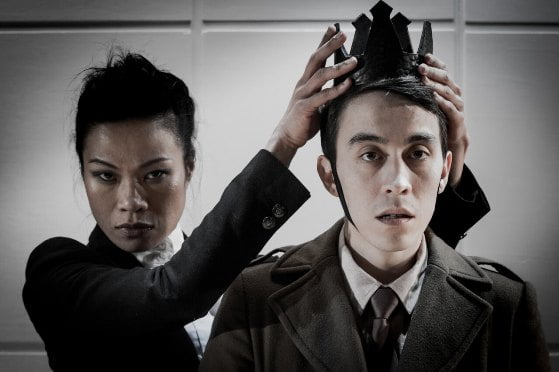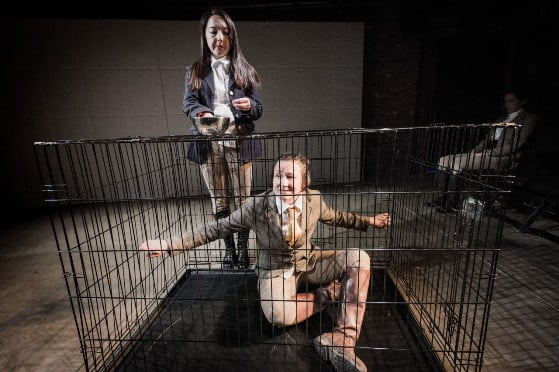
To the Arcola Theatre in Hackney to see Tamburlaine, a play I’d not seen staged before (two plays, to be precise, since Christopher Marlowe wrote a sequel after part one had been a success). Studio 2 at the Arcola is a brick-walled basement that in other circumstances might have served well enough as a double garage with a little space left over for some bikes.
About thirty of us were seated in three rows on three sides facing a white, squared screen and a modest acting space. Our number was reduced somewhat when six got up and turned out to be the performers. The Yellow Earth theatre company champions British East Asian writers and performers, and all the cast (bar one, I think) were BEA of one kind or another. Five out of the six were female. And five out of the six played multiple roles, the exception being Lourdes Faberes, who strutted over all as Tamburlaine himself.
The actors were all very accomplished, not least in how they differentiated the different roles each had to play (including some smart use of Yorkshire accents). The beautiful words were always beautifully spoken. I was particularly impressed by Leo Wan, playing six roles including the weak Persian king Mycetes and Tamburlaine’s unwarlike son Calyphas, a player who always caught the eye; and Susan Hingley, bright and engaged, especially adroit in switching instantly from playing the dying Empress Zabina to the equally doomed Sigismund, King of Hungary. A Chinese drummer (female) was positioned to one side, providing skilful and appropriate accompaniment throughout.
The two plays were condensed into one by director Ng Choon Ping, with huge amounts cut and sequences not always in the order Marlowe has them. Curiously the most notorious scene from part one, in which the Emperor Bajazeth and his wife Zabina bash their brains out against the bars of the cage in which Tamburlaine has imprisoned them (it’s that sort of a play) had no brain-bashing, had only Bajazeth in the cage, and their quieter deaths took place in the second half of the play rather than at the end of the original part one.
The most notorious scene in part two, in which Tamburlaine burns a copy of the Koran to show that he fears no god, was deftly covered by having no book or burning but only some melting words on the screen. At other points the screen was used helpfully to give the names of the lead character at each scene change. It would have been all too easy to have got lost otherwise.
The fact that women played most of the roles (male and female) was intriguing without altering the sense of the plays at all, while their Asian inheritance was an interesting corrective to Western orientalism, since Tamburlaine takes place across the vast stage of central Asia. This was Marlowe under Eastern eyes.

It is good to see our conquerors reduced to size. Tamburlaine, or Timur, who conquered most of central Asia, slaughtering an estimated 5% of the world’s population in the process, was here reduced to lording it over five actors and twenty-five of us seated around the perimeter, while the rest of world went about its business on the outside. The stage cuts such aspiring minds down to size. That must be why tragedy is such a natural part of drama – not simply because it is a kind of story that shows the folly of human ambition, but because such ambition is trapped in space, constrained by bare walls.
Tamburlaine is an odd tragedy, however. It has no dramatic fall. In part one Tamburlaine conquers all who dare to challenge him, displays unremitting cruelty, but suffers no comeuppance. In part two the bloodlust continues, and when he taunts the gods to punish him no punishment is forthcoming. He dies, but though there is some acknowledgment that he who taunts God must in the end face up to his humanity (his last words are “Tamburlaine, the scourge of God, must die”), it does not convince us as tragedy. Tamburlaine may be devoid of goodness, but he has no flaw. He is never to be pitied. We can only fear and admire him.
Tamburlaine was a huge hit in its time. Audiences saw it as something that brought a new command of time, history and resonance to the English stage. They must have thrilled also to its transgression it offered – emperors reduced to being held in cages, or kings with bridles in their teeth forced to pull like a team of horses. And the sight of gods that did not strike back.
Chiefly, they saw the world translated to the stage. Not merely the obvious dramatic conceit, but the whole intellectual and emotional charge that being in the world meant. That charge remains on our stages today, but in a force that is much reduced. We see greatness in its contexts, and its littleness. We saw tyranny in a bottle, something to peer at with curiosity and a shudder, then to don our coats, head up the stairs, and into the freedom of the evening air.
Links:
- Tamburlaine is playing at the Arcola until April 8th